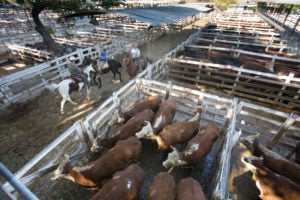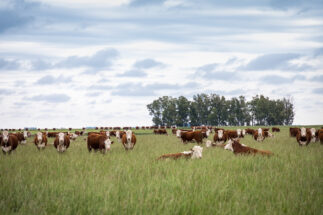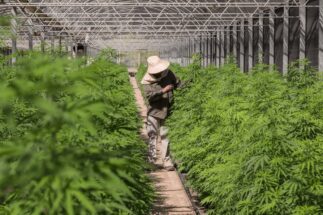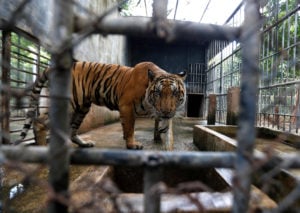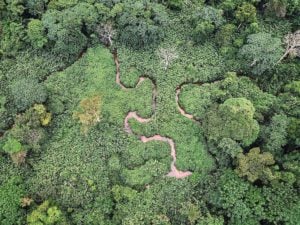Nitrogen is an essential nutrient in agriculture, helping plant roots to grow, leaves to become greener and crops to thrive. The application of nitrogen-based fertilisers can make a significant difference to yields and growth, even for the grasses that cattle feed on. The great leap in productivity seen in Brazilian agriculture and livestock farming over the last four decades would not have been possible without boosting nitrogen levels through the widespread use of fertilisers.
Such abundance in production, however, has an environmental cost. The use of nitrogen-based fertiliser generates a dangerous greenhouse gas: nitrous oxide. This gas remains in the atmosphere for over a hundred years, and has a warming potential 264 times greater than carbon dioxide. It is also the most significant ozone-depleting substance.
In Brazil in 2021, nitrous oxide emissions from the use of synthetic fertiliser reached 37.5 million tonnes of carbon dioxide equivalent, according to data from the System for Estimating Greenhouse Gas Emissions (SEEG), an initiative of the Climate Observatory, a Brazilian climate science network. These releases are almost equivalent to the total carbon dioxide emissions in 2021 of entire countries, including Portugal, Finland and Azerbaijan.
Nitrous oxide’s impact on the atmosphere has given rise to discussions over reducing, restricting or even banning the use of nitrogen fertilisers. In New Zealand, Greenpeace is campaigning for an end to the use of synthetic nitrogen fertiliser. In Canada, the government has announced plans to reduce emissions linked to nitrogen fertiliser use, while plans in the Netherlands to halve nitrogen emissions by 2030 have come up against a fierce farmers’ protest movement.

In Brazil, however, no policy moves to reduce nitrogen-based emissions have yet been seen. “The country needs to scale up low-carbon agriculture policies to contain emissions,” says Renata Potenza, a researcher for SEEG, which campaigns for better management of fertiliser use. Producers’ activities, she adds, are slowing down Brazil’s achievement of the Paris Agreement.
Farming emissions
Along with his sons, Antônio Sebastiani manages a farm in Cerquilho, a town about 150 kilometres west of São Paulo. At the end of March, Sebastiani showed Diálogo Chino around his property, taking us to a shed where he stores sacks of urea, a white crystalline substance containing a high amount of nitrogen, which he uses to fertilise his pastures. Every year, the farm fattens about a thousand cattle, which he supplies to meatpacking plants across the region.

An agronomist and cattle breeder for over 40 years, Sebastiani uses the input to “put the finishing touches” on his pastures. “Urea brings so much vigour to plants that some producers think they have discovered the seventh wonder of the world,” he says.
Wonder, however, isn’t the best word to describe most Brazilian farms. “I can guarantee that 95% of pastures are in terrible condition,” says Sebastiani, due to what he calls “backward” practices, including improper use of fertiliser. “There is a lack of information about soil management. It is essential to follow technical recommendations to avoid wear and tear.”
Emissions resulting from the use of fertilisers are not a concern for Sebastiani, who describes his fertiliser use on pastures as “minimal”.

In Brazil, agriculture, including livestock farming, is by far the sector responsible for the largest share of nitrous oxide emissions, according to estimates by the Ministry of Science, Technology and Innovation. Large-scale cultivation of corn, sugarcane, cotton and coffee are the crops that demand the most significant nitrogen inputs.
In 2021, greenhouse gas emissions from managed soils in Brazil reached an estimated 179 million tonnes of carbon dioxide equivalent, of which 49% were nitrous oxide emissions from the use of manure and synthetic fertilisers, according to the Climate Observatory. Farming is also the country’s second largest source of total emissions, in carbon dioxide equivalent, behind deforestation and land use change.
Nitrogen-based fertilisers can cause other environmental impacts beyond emissions. These products need to be used in the dry season, explains Sebastiani, to prevent rains from carrying the fertiliser to rivers, where they can cause eutrophication – the accumulation of toxic algae that has negative effects for aquatic biodiversity.

Specialists say nitrogen-based emissions could be reduced through more efficient use of fertilisers. The FertBrasil Caravan is a programme run by Embrapa, an organisation linked to the country’s agriculture ministry, which travels through the country’s agricultural hubs sharing improved land management practices. “What is missing is guidance,” says Paulo Teixeira, a researcher who is part of the travelling team.
Teixeira advises producers on the choice of fertiliser, and the area, time and dose of its application, in order to increase productivity per hectare and thus reduce the incentive to deforest new areas.
Urea brings so much vigour to plants that some producers think they have discovered the seventh wonder of the world
Edson Savazaki, an agronomist at the Coordinator for Technical Assistance (CATI), a São Paulo state agency that supports rural producers, says that the most common approach is for producers to fertilise monthly in order to cut costs. But increasing the frequency would avoid waste, and mitigate negative environmental impacts.
“We eat our rice and beans every day, no? The ideal situation would be to feed the plant every day too, a little bit at a time,” explains Savazaki.
He also suggests the use of slow-release fertilisers whose formulas are better adjusted to plants’ needs, though these are more expensive alternatives.
Brazil depends on nitrogen imports
Brazil imports 95% of its nitrogen fertilisers. In 2021, the country’s largest suppliers were China and Russia, with each accounting for a fifth of imports, at roughly 3 million tonnes each, according to Brazilian foreign trade data. But in 2022, the global fertiliser market saw significant disruptions due to the onset of war in Ukraine and China’s energy crisis, which led the Chinese government to prioritise its domestic market and restrict exports. Nonetheless, Brazil managed to increase imports from China to 4.6 million tonnes, as supply from Russia dwindled to 1.8 million tonnes.
It is not clear whether China’s commitments to emission reductions will affect this market more in the long term. So far, it has not: China’s 14th Five-Year Plan, launched in 2020, indicated restrictions on energy- and emissions-intensive industries and a reduction in the use of coal – one of the feedstocks used in the production of fertiliser. But since December 2021, China has permitted the continued use of coal by fertiliser producers to ensure domestic supply.
While Russia continues to impose restrictive fertiliser export quotas, China has opened up its sales to Brazil, its main client. Between 2018 and 2022, China’s share of Brazilian nitrogen fertiliser imports (by tonnes purchased) rose from 15% to 34.5%, according to Brazilian foreign trade data.
Brazil has plans to subsidise domestic production of nitrogen fertilisers, but it cannot plausibly come close to making the country self-sufficient: by 2050, the government aims to have enough capacity to produce 2.8 million tonnes of nitrogen products a year, only half of what the country consumed in 2022.
The fertiliser market, therefore, remains an important point of discussion between Brazilian, Russian and Chinese authorities. It was a key issue on the agenda of Brazil’s agriculture minister, Carlos Fávaro, on his recent trip to China, and among the priorities during Russian foreign minister Sergei Lavrov’s visit to Brasília last week. So far, however, no further information has emerged over possible agreements between Brazil and the nations on fertilisers.
Yedan Li contributed to this report.

